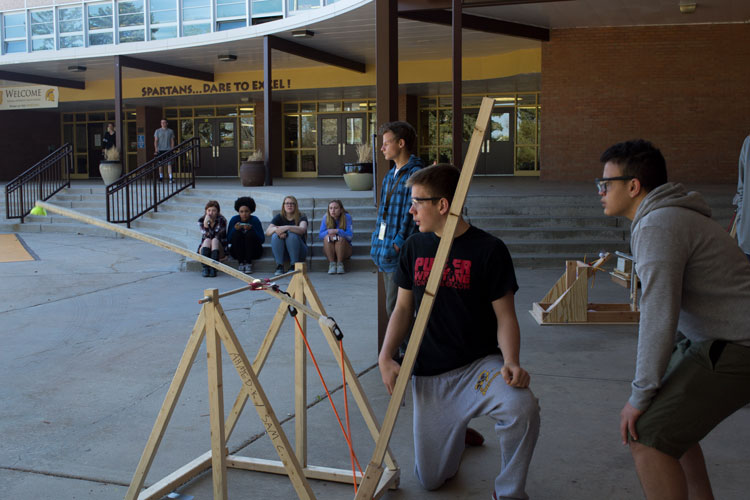
Teammates Sam Cole and Ahmed Khattab fire their catapult at targets set up by physics teacher Nelson Vore. photo by Lucy Peterson
Physics students strive for greatness in the annual catapult competition.
On Thursday, April 20th, physics students congregated to compete in a catapult battle. Students had spent weeks preparing and building their catapults, and were put to the final test by physics teacher Nelson Vore. Participants had been assigned to build a catapult in groups or alone, with a base able to fit within a 1×1 meter square. In addition to this, one side of the base had to be at least 50 cm long.
On the day of the competition, the students lined up their catapults and took three shots – one at a short distance, one at an intermediate distance, and a final shot at long range. The catch? Students had no knowledge of the distances they would be aiming for until moments before they ran their final trial. Cans were placed anywhere from five to eleven meters from the base of the catapult, meaning that the students needed to know what setting would yield the best results at the randomly assigned distance. Like golf, the catapult competition is scored in reverse – the fewer the points, the better. Students took turns firing at the cans, adjusting the setting on their catapults to accommodate the assigned intervals of the cans.
After the smoke had cleared, one person emerged victorious: junior Zane Leaver. He ended his run with a score of -168, the lowest score Vore thinks he has seen in over 10 years of running the competition. Though most students paired off into small teams, Leaver decided to take on the burden of doing all the work. Instead of the conventional catapult, Leaver decided to design a ballista for the competition. He mentioned, “I worked for 7 hours, maybe 10. It was a lot of work.” Ultimately, however, the results he got out of his work were gratifying. He had a blast shooting his ballista and, as he put it, “Extra credit is pretty great.”
With this project, students not only learn mechanics of catapults and how to apply physics to projectiles, but they also learn valuable critical thinking skills. “It is one thing to talk about projectile motion and forces and accelerations and energy, it is a totally different thing to turn that into cut wood and driven nails and tennis balls flying around. It is the first experience with the great fact that a lot of time, frustration and hard work are required to turn ideas into reality. Plus, it is a lot of fun,” explained Vore.
Sophomore Jon Emmanuel Serrano said, “It definitely made me think. We had to solve a lot of issues and account for a lot of factors.” Students such as Serrano and his group partner, sophomore Tylin Holzer, encountered many problems that had to be solved. Holzer noted, “We had to try many times to establish settings on the catapult for different distances.” Eventually though, the trial-and-error process paid off for the participants, resulting in finely tuned catapults.
In the end, students gained experience working with teammates, designing and testing an effective model, and insight into the relationship between physics and the world around them. By assigning students a fun project that will give them useful skills and knowledge, Vore is helping to prepare these students for the future.